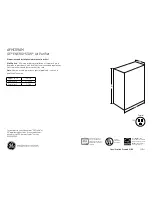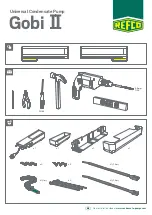
NORMAL MAINTENANCE
CAUTION: Prior to any of the following maintenance proce-
dures, shut off all power to the unit to prevent
personal injury.
Periodic maintenance normally consists of changing or cleaning
filters and (under some conditions) cleaning the main burners.
FILTERS - Inspect once a month. Replace disposable or clean
permanent type as necessary. DO NOT replace permanent
type with disposable.
MOTORS - Indoor fan and outdoor fan motors are permanently
lubricated and require no maintenance. Ventor motor is factory
lubricated for an estimated 10 year life.
OUTDOOR COIL - Dirt should not be allowed to accumulate
on the outdoor coil surface or other parts in the air circuit.
Cleaning should be as often as necessary to keep coil clean.
Use a brush, vacuum cleaner attachment, or other suitable
means. If water is used to clean coil, be sure power to the unit
is shut off prior to cleaning.
NOTE: Exercise care when cleaning the coil so that the coil
fins are not damaged.
Do not permit the outdoor air discharge to be ob-
structed by overhanging structures of shrubs.
BURNER & PILOT - Periodically (at least annually at the beginning
of each heating season) make a visual check of the pilot and main
burner flame. If necessary, adjust main burner primary air shutters
so that no yellow flame is observed as explained under “BURNER
AIR SHUTTER ADJUSTMENT”. If it is not possible to adjust for
the proper flame, the burners may need cleaning.
TO CLEAN BURNERS - Remove them from the furnace as
explained in “Burner Instructions”. Clean burners with hot water
applied along top of the burner.
COMBUSTION AIR DISCHARGE - Visually inspect discharge
outlet periodically to make sure that the buildup of soot and dirt
is not excessive. If necessary, clean to maintain adequate
combustion air discharge.
The manufacture recommends that the furnace system be
inspected once a year by a qualified service person.
CLEANING FLUE PASSAGES AND HEATING
ELEMENTS
With proper combustion adjustment the heating element of a
gas fired furnace will seldom need cleaning. If the element
should become sooted, it can be cleaned as follows:
1. Remove the burner assembly as outlined in “BURNER
INSTRUCTIONS”.
2. Remove the roof over the gas heat section.
3. At the top front of the heat section, remove the screws
holding the top of the flue collector box. Carefully remove
the top of the flue collector box without ripping the adjacent
insulation.
4. Lift out the flue diverter baffle.
5. On the inside of the flue collector box, remove the screws
holding the flue baffle. Remove the flue baffle.
6. Using a wire brush on a flexible wand, brush out the inside
of each heat exchanger from the burner inlet and flue outlet
ends.
7. Brush out the inside of the flue collector box and the flue
baffles.
8. Run the wire brush down the vent tube from the flue
collector end.
9. If soot build-up is particularly bad, remove the vent motor
and clean the wheel and housing. Run the wire brush down
the flue extentions at the outlet of the vent housing.
10. After brushing is complete, blow all brushed areas with air
or nitrogen. Vacuum as needed.
11. Replace parts in the order they were removed in Steps
1 to 5.
12. When replacing the top of the flue collector box, be careful
so as not to tear the adjoining insulation.
13. Assure that all seams on the vent side of the combustion
system are air tight. Apply a high temperature (+500
°
F)
sealing compound where needed.
MAINTENANCE
TROUBLESHOOTING
c. If “BR” is pulled in and the blower motor still does not
run, replace the blower motor.
d. If “BR” is not pulled in check for 24 volts at the “BR” coil.
If 24 volts is present, replace the “BR” relay.
e. If 24 volts is not present at the “BR” coil, check for loose
24 volt wiring back to the relay board. Check control
wiring to the room thermostat. If all is fine, replace the
relay board.
f. If the blower motor runs with the fan switch in the “ON”
position but does not run soon after the furnace has
ignited with the fan switch in the “AUTO” position, check
for loose 24 volt wiring between the relay board in the
main control box, the Mate-N-Lok connector in the
partition between the evaporator and gas heat sections
and the time delay “BT” or “ETD”.
g. If all control wiring is fine, check for 24 volts at the relay
board. If 24 volts is present, replace the relay board. If
24 volts is not present, replace the “BT” or “ETD”.
NOTE: The furnace may shut itself down on a high tempera-
ture condition during the procedure but this will not
effect the test if it is done within 5 minutes of furnace
shut-down.
WARNING: Troubleshooting of components necessarily re-
quires opening the electrical control box with the
power connected to the unit. Use extreme care
when working with live circuits! Check the unit
nameplate for the correct line voltage and set the
volt meter to the correct range before making any
connections with line terminals.
CAUTION: The wire number or color and terminal designations
referred to may vary. Check the wiring label inside the
control box access panel for the correct wiring.
1. Draft motor operates and furnace lights but supply air
blower does not start after a short time delay with room
thermostat fan switch set to “AUTO”.
a. Set fan switch to “ON”. If blower motor runs, go to Step
f. If it does not, check to see if line voltage is being
supplied to the contacts of the blower relay, “BR”, and
if the blower relay is pulled in. Check for loose wiring.
b. If “BR” is pulled in, touch the supply air blower motor
housing. If it is hot the motor may be off on inherent
protection. Disconnect power to the unit and check the
blower motor capacitor. If it is defective, replace it with
one of equal capacitance and voltage.
530.18-N8W
18
Unitary Products Group



































